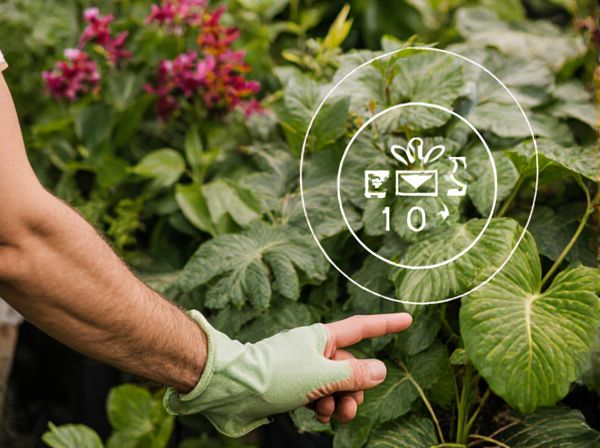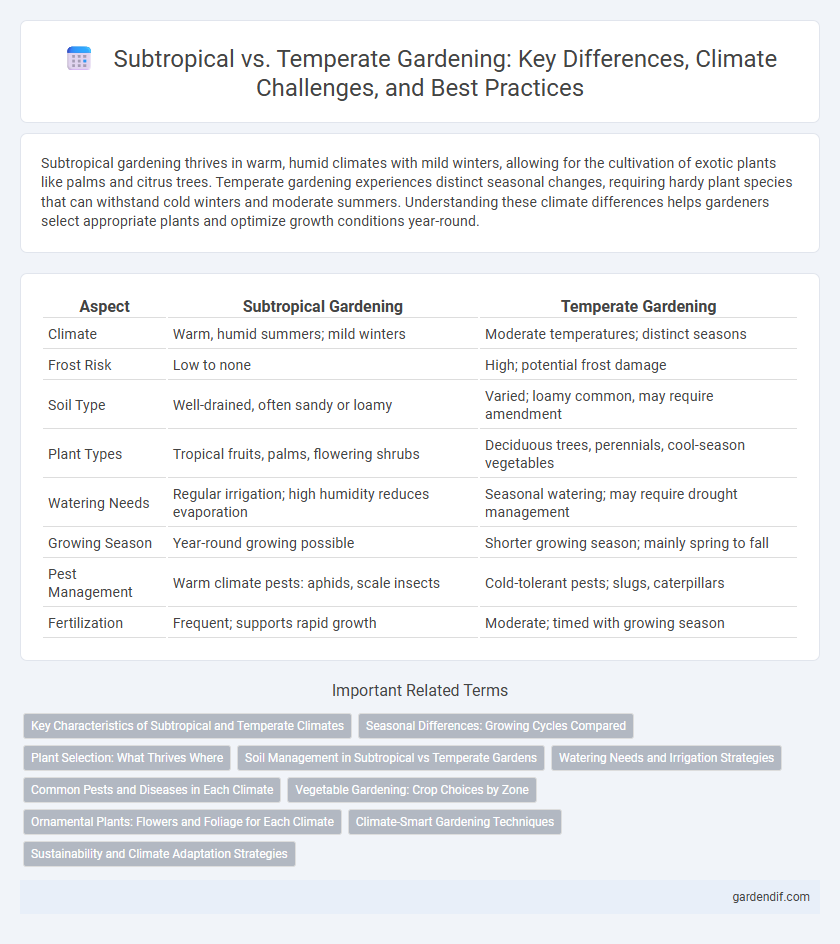
Subtropical gardening vs temperate gardening Illustration
Subtropical gardening thrives in warm, humid climates with mild winters, allowing for the cultivation of exotic plants like palms and citrus trees. Temperate gardening experiences distinct seasonal changes, requiring hardy plant species that can withstand cold winters and moderate summers. Understanding these climate differences helps gardeners select appropriate plants and optimize growth conditions year-round.
Table of Comparison
| Aspect | Subtropical Gardening | Temperate Gardening |
|---|---|---|
| Climate | Warm, humid summers; mild winters | Moderate temperatures; distinct seasons |
| Frost Risk | Low to none | High; potential frost damage |
| Soil Type | Well-drained, often sandy or loamy | Varied; loamy common, may require amendment |
| Plant Types | Tropical fruits, palms, flowering shrubs | Deciduous trees, perennials, cool-season vegetables |
| Watering Needs | Regular irrigation; high humidity reduces evaporation | Seasonal watering; may require drought management |
| Growing Season | Year-round growing possible | Shorter growing season; mainly spring to fall |
| Pest Management | Warm climate pests: aphids, scale insects | Cold-tolerant pests; slugs, caterpillars |
| Fertilization | Frequent; supports rapid growth | Moderate; timed with growing season |
Key Characteristics of Subtropical and Temperate Climates
Subtropical climates feature hot, humid summers and mild winters, supporting plants like citrus trees, hibiscus, and palms that thrive in extended growing seasons with minimal frost. Temperate climates experience distinct seasons with moderate rainfall, cold winters, and warm summers, favoring deciduous trees, bulbs, and perennials adapted to seasonal temperature fluctuations. Subtropical gardening emphasizes heat-tolerant and drought-resistant species, while temperate gardening relies on cold-hardy plants requiring chilling periods for dormancy and flowering.
Seasonal Differences: Growing Cycles Compared
Subtropical gardening features extended growing seasons with minimal frost risk, enabling year-round cultivation of heat-tolerant plants such as citrus and avocados. Temperate gardening experiences distinct seasonal changes, including cold winters and warm summers, which dictate specific planting and harvesting periods for crops like apples and tulips. Understanding these seasonal differences is crucial for optimizing plant selection and crop management in each climate zone.
Plant Selection: What Thrives Where
Subtropical gardening features plant species such as hibiscus, palms, and citrus trees that thrive in warm, frost-free conditions with high humidity, while temperate gardening favors hardy perennials, deciduous trees, and cool-season vegetables adapted to seasonal temperature fluctuations and occasional frost. In subtropical zones, gardeners prioritize plants with heat tolerance and moisture resilience, whereas temperate regions require species capable of surviving cold winters and moderate summers. Understanding the climatic needs of plants ensures optimal growth and sustainable garden ecosystems in each zone.
Soil Management in Subtropical vs Temperate Gardens
Subtropical gardening demands soil management techniques that emphasize moisture retention and nutrient cycling due to higher temperatures and humidity, often requiring organic mulches and regular amendment with compost to sustain fertility. In contrast, temperate soil management involves addressing seasonal fluctuations, focusing on improving drainage and preventing nutrient leaching during cold, wet months through cover cropping and soil aeration. Both climates benefit from pH monitoring, but subtropical soils often require more frequent adjustments to prevent acidification under intense rainfall.
Watering Needs and Irrigation Strategies
Subtropical gardening requires less frequent but deeper watering due to higher soil evaporation rates and drought-tolerant plant species, while temperate gardening often demands consistent moisture levels to support seasonal plant growth cycles. Efficient irrigation strategies in subtropical regions include drip irrigation and mulching to conserve water and reduce evaporation, whereas temperate gardens benefit from rainwater harvesting systems combined with automated sprinklers tailored to variable rainfall patterns. Understanding these distinct watering needs optimizes plant health and water conservation in both climate zones.
Common Pests and Diseases in Each Climate
Subtropical gardening often contends with pests such as aphids, whiteflies, and scales, which thrive in warm, humid conditions, alongside diseases like powdery mildew and root rot common in moist environments. Temperate gardening frequently faces challenges from slugs, caterpillars, and fungal pathogens including rust and blight, which proliferate during cooler, wetter seasons. Effective pest management varies with climate, emphasizing integrated pest control in subtropical zones and disease-resistant plant varieties in temperate regions.
Vegetable Gardening: Crop Choices by Zone
Subtropical vegetable gardening favors heat-tolerant crops such as okra, sweet potatoes, and eggplant, which thrive in prolonged warm seasons and high humidity. Temperate zones support a wider variety of cool-season vegetables like broccoli, spinach, and carrots, benefiting from distinct seasonal temperature fluctuations. Selecting crops aligned with zone-specific climate conditions maximizes yield and reduces pest and disease pressure.
Ornamental Plants: Flowers and Foliage for Each Climate
Subtropical gardening features ornamental plants like hibiscus, bougainvillea, and bird of paradise, thriving in warm, humid conditions with vibrant flowers and lush foliage. Temperate gardening favors species such as lilac, hydrangea, and hosta, which adapt well to cooler seasonal changes and provide a balance of colorful blooms and textured leaves. Plant selection in each climate depends on temperature tolerance, frost resistance, and water requirements to ensure healthy growth and ornamental appeal.
Climate-Smart Gardening Techniques
Subtropical gardening thrives in warm climates with mild winters, requiring heat-tolerant, drought-resistant plants that optimize water usage and soil health. Temperate gardening emphasizes seasonal changes with frost-hardy species, focusing on mulching, crop rotation, and water conservation to enhance resilience. Both climate-smart gardening techniques integrate efficient irrigation, organic soil amendments, and native plants to reduce environmental impact and adapt to climate variability.
Sustainability and Climate Adaptation Strategies
Subtropical gardening leverages native drought-resistant plants and mulching techniques to conserve water and enhance soil health, making it highly sustainable in warm, humid climates. Temperate gardening emphasizes crop rotation, organic composting, and seasonal planting to optimize growth cycles and reduce pest vulnerability, effectively adapting to fluctuating temperatures and precipitation patterns. Both gardening practices incorporate climate-resilient species selection and efficient water management to promote biodiversity and carbon sequestration, strengthening ecosystem stability amid climate change.
Subtropical gardening vs temperate gardening Infographic

 gardendif.com
gardendif.com